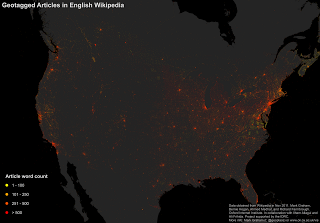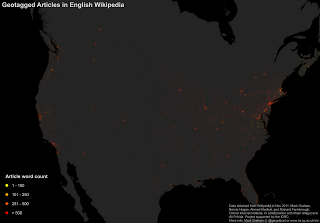But not all articles are created equally, and those maps didn’t give us much of a sense of the quality of articles. “Quality” is obviously a slippery word and there are infinite ways of measuring it, but for the purposes of this post, we’ll crudely use the term to refer to article length (future maps will employ a variety of other metrics).
The maps below visualize this measure of quality within Wikipedia entries — yellow dots represent the location of relatively short articles in the English version of Wikipedia (e.g. the article on “
Bandana, Kentucky“), while red dots indicate the location of relatively long articles (e.g. the articles on the “
Republic of Molossia“.
The map below displays the same data, but with smaller dots: making it easier to see some of the patterns if you expand the image.
Interestingly, the states with the highest average word counts are New Jersey (966) and Michigan (914). The states with the lowest averages are Delaware (534) and West Virginia (492). The reasons for these rather large differences are unclear.
Are Wikipedians from New Jersey that much more loquacious than their West Virginian counterparts? Or does it just take more words to describe the many dazzling wonders of New Jersey? Or is it something else entirely?
Apart from the obvious and increasingly evident urban bias in these information geographies, we’d certainly welcome your thoughts in explaining some of these patterns.


